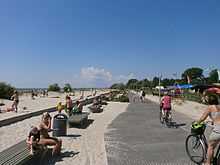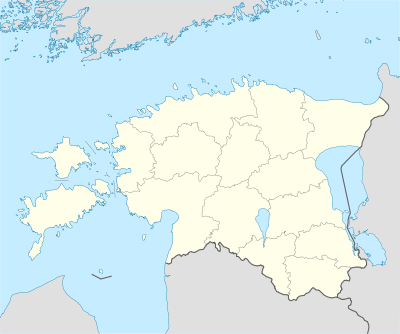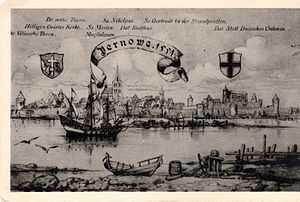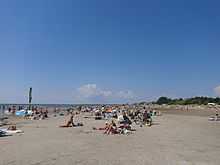Pärnu
| Pärnu Pärnu | |||
|---|---|---|---|
 Pärnu beach promenade Pärnu beach | |||
| |||
 Pärnu Location of Pärnu | |||
| Coordinates: 58°23′N 24°30′E / 58.383°N 24.500°ECoordinates: 58°23′N 24°30′E / 58.383°N 24.500°E | |||
| Country | Estonia | ||
| County | Pärnu County | ||
| Founded | 1251 | ||
| Government | |||
| Area | |||
| • Total | 32.22 km2 (12.44 sq mi) | ||
| Elevation | 10 m (30 ft) | ||
| Population (2014) | |||
| • Total | 41 528 | ||
| Ethnicity | |||
| • Estonians | 83% | ||
| • Russians | 12% | ||
| • other | 5% | ||
| Time zone | EET (UTC+2) | ||
| • Summer (DST) | EEST (UTC+3) | ||
| Area code(s) | (+372) 44 | ||
| Vehicle registration | F | ||
| Website | www.parnu.ee | ||
Pärnu (Estonian pronunciation: [ˈpærˑnu]; German: Pernau, Russian: Пернов, Pernov, Pernow, Polish: Parnawa, Latvian: Pērnava) is a city in southwestern Estonia on the coast of Pärnu Bay, an inlet of the Gulf of Livonia in the Baltic Sea. It is a popular summer vacation resort with many hotels, restaurants, and large beaches. The Pärnu River flows through the city and drains into the Gulf of Riga. The city is served by Pärnu Airport.

History
Perona (German: Alt-Pernau, Estonian: Vana-Pärnu) was founded by the bishop of Ösel–Wiek ca. 1251, suffered heavily under pressure of the concurrent town, and was finally destroyed ca. 1600. Another town, Embeke (later German: Neu-Pernau, Estonian: Uus-Pärnu) was founded by the Livonian Order, who began building an Ordensburg nearby in 1265. The latter town, then known by the German name of Pernau, was a member of the Hanseatic League and an important ice-free harbor for Livonia. The Polish–Lithuanian Commonwealth took control of town between 1560–1617; the Poles and Lithuanians fought the Swedes nearby in 1609. Sweden took control of the town during the 16th-century Livonian War, but it was subsequently taken by the Russian Empire in the 1710 Capitulation of Estonia and Livonia and the 1721 Treaty of Nystad, following the Great Northern War. It belonged to Imperial Russian Governorate of Livonia then. The city is occasionally referred to as Pyarnu, an incorrect reverse-transliteration from Russian Пярну.
The town became part of independent Estonia in 1918 following World War I.
During the Great Northern War, the University of Dorpat (Tartu) was relocated to Pernau from 1699–1710. The university has a branch campus in Pärnu today (1,000 students in the 2004/2005 school year).
Climate
Pärnu lies within the temperate humid continental climate zone.
| Climate data for Pärnu | |||||||||||||
|---|---|---|---|---|---|---|---|---|---|---|---|---|---|
| Month | Jan | Feb | Mar | Apr | May | Jun | Jul | Aug | Sep | Oct | Nov | Dec | Year |
| Record high °C (°F) | 9.0 (48.2) |
8.3 (46.9) |
18.1 (64.6) |
26.2 (79.2) |
31.2 (88.2) |
32.6 (90.7) |
33.2 (91.8) |
31.8 (89.2) |
28.0 (82.4) |
22.4 (72.3) |
12.0 (53.6) |
10.3 (50.5) |
33.2 (91.8) |
| Average high °C (°F) | −1.9 (28.6) |
−1.6 (29.1) |
2.4 (36.3) |
9.6 (49.3) |
16.4 (61.5) |
19.9 (67.8) |
22.5 (72.5) |
21.2 (70.2) |
15.8 (60.4) |
9.8 (49.6) |
3.6 (38.5) |
0.2 (32.4) |
9.9 (49.8) |
| Daily mean °C (°F) | −3.5 (25.7) |
−4.5 (23.9) |
−1.0 (30.2) |
4.8 (40.6) |
11.4 (52.5) |
15.2 (59.4) |
18.0 (64.4) |
16.9 (62.4) |
11.9 (53.4) |
6.9 (44.4) |
1.6 (34.9) |
−1.9 (28.6) |
6.3 (43.3) |
| Average low °C (°F) | −5.9 (21.4) |
−7.2 (19) |
−4 (25) |
1.1 (34) |
6.6 (43.9) |
10.8 (51.4) |
13.7 (56.7) |
13.0 (55.4) |
8.5 (47.3) |
4.2 (39.6) |
−0.5 (31.1) |
−4.4 (24.1) |
3.0 (37.4) |
| Record low °C (°F) | −32.7 (−26.9) |
−28.5 (−19.3) |
−22.7 (−8.9) |
−10.7 (12.7) |
−3.6 (25.5) |
1.6 (34.9) |
4.0 (39.2) |
3.7 (38.7) |
−3.1 (26.4) |
−10.3 (13.5) |
−22.2 (−8) |
−24.2 (−11.6) |
−32.7 (−26.9) |
| Average precipitation mm (inches) | 60 (2.36) |
44 (1.73) |
44 (1.73) |
37 (1.46) |
37 (1.46) |
73 (2.87) |
79 (3.11) |
79 (3.11) |
67 (2.64) |
83 (3.27) |
75 (2.95) |
67 (2.64) |
746 (29.37) |
| Average relative humidity (%) | 88 | 86 | 82 | 75 | 70 | 74 | 76 | 79 | 83 | 86 | 89 | 89 | 81 |
| Mean monthly sunshine hours | 35.9 | 67.9 | 130.7 | 198.7 | 288.9 | 281.3 | 297.4 | 246.9 | 159.7 | 95.5 | 39 | 26.1 | 1,863.6 |
| Source: Estonian Weather Service (normals 1981-2010) http://www.ilmateenistus.ee/kliima/kliimanormid/sademed/?lang=en'' | |||||||||||||
Population
| 1881 | 1897 | 1922 | 1934 | 1959 | 1970 | 1979 | 1989 | 2000 | 2009 |
|---|---|---|---|---|---|---|---|---|---|
| 12966 | 12898 | 18499 | 20334 | 22367 | 50224 | 54051 | 53885 | 46476 | 44024 |
Administration
Local administration consists of the town council and the town government. Town council elections take place every four years. The number of councillors depends on the population. The current number of councillors is 33. Estonian National Electoral Committee, Local government council elections
- October 2005
- 18. October 2009[1]
- 20. October 2013
Tourism

Pärnu is a health resort of international stature. In addition to guests arriving from around fifty countries, it is also proved by its membership in the European Spas Association (since 2000) and the European Flag that has been flying at the beach of Pärnu since 2000. Many tourists in Pärnu are Finns and Estonians. Hotel and restaurant staff speak English, Russian and some Finnish in addition to Estonian.
In 1837, a few business-minded entrepreneurs decided to rebuild a lone tavern near the beach into a bathing establishment, thus preparing the ground for the development of the resort of Pärnu. This wooden building was the predecessor of the present-day mud baths. The establishment, which was opened in 1838, accommodated 5–6 bathrooms that provided hot seawater baths in summer and operated as a sauna in winter. The wooden building was burnt down in the course of World War I. In 1927, the present stone building of Pärnu Mud Baths was erected at the same site. Later, the wings were attached to the building to accommodate a bath unit and a pool.
Today, disorders of the joints, spinal column and peripheral nervous system, gynaecological problems and dysfunction of the central nervous system are treated at Pärnu Mud Baths. The therapies include hydrotherapy, mud and ozocerite therapies, massage, laser and electrotherapies, lymph and inhalation therapies, aromatherapy and ECG. There are 130 rooms in the hotel of the Mud Baths. Today, Pärnu is the most popular health tourism destination in Estonia.
Since 1996 Pärnu has been known as Estonia's Summer Capital.[2][3]
Twin towns and sister cities
|
|
|
Citizens of honour
- 1886 Konstantin Possiet
- 1901 Friedrich Fromhold Martens
- 1934 Konstantin Päts
- 2007 Neeme Järvi
- 2008 Valter Ojakäär
- 2009 Jüri Jaanson[6]
Notable residents
- Gustav Fabergé, jeweller
- Johann Voldemar Jannsen, Estonian journalist and poet
- Paul Keres, chess grandmaster
- Lydia Koidula, poet
- Friedrich Martens, lawyer
- David Oistrakh, violinist
- Georg Wilhelm Richmann, German physicist
- David Samoylov, poet
- Olev Siinmaa, architect
- David Shrayer-Petrov, poet, fiction writer, translator, medical scientist
- Maxim D. Shrayer, author and literary scholar
References
- ↑ 2009 Elections results
- ↑ suvepealinn
- ↑ Short history – VisitPärnu.com
- ↑ Pärnu linna veeb: Sõpruslinnad
- ↑ Lindquist, Ted. "Internationella frågor och vänorter". Oskarshamn Municipality (in Swedish). Retrieved 2013-07-25.
- ↑ Pärnu linn: Pärnu aukodanik
Maxim D. Shrayer. Dunes of Happiness: Fifteen Summers in Estonia. Baltic Worlds (September 2013).
External links
| Wikimedia Commons has media related to Pärnu. |
| Wikivoyage has a travel guide for Pärnu. |
- The Official Tourist Information Centre Foundation of Pärnu
- City of Parnu: Official website (in English)
- Parnu tour overview
- Satellite photo from May, 2004
- Sightseeing on Your own
- MERKO: 2010–2011 Pärnu moat and park area reconstruction, land reclamation and landscaping, with 6 photos
| |||||||||||||
| ||||||||||||
| ||||||||||||||||||||||||||||||||||||||||||||||||||||||||
| ||||||||||||||||||||||||||||||||||


